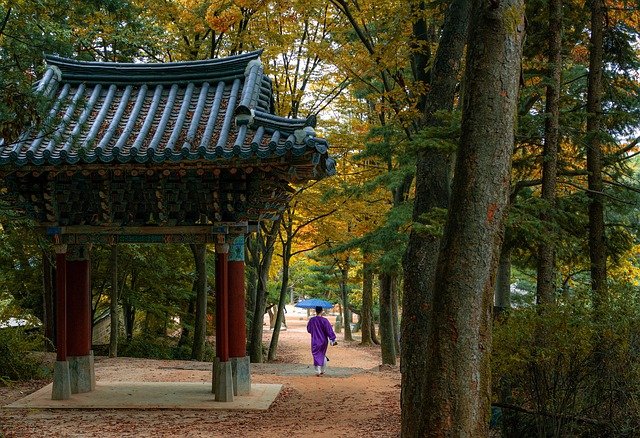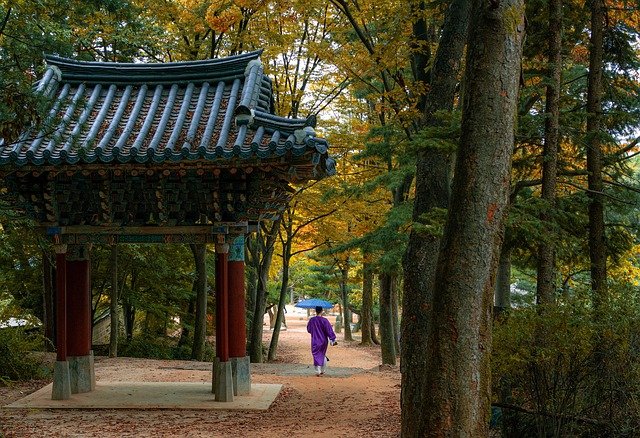
Traditional Korean Cuisine: Exploring the Rich Flavors and Unique Dishes
Korean cuisine is known for its rich flavors and unique dishes that have been passed down through generations. Traditional Korean cuisine is deeply rooted in the country’s history and culture, and it reflects the values and beliefs of the Korean people. From the use of fresh ingredients to the meticulous preparation methods, every aspect of Korean cuisine tells a story.
One of the key characteristics of traditional Korean cuisine is its emphasis on balance and harmony. Korean meals are typically composed of a variety of dishes that include rice, soup, and several side dishes. This balanced combination ensures that each meal provides a complete and nutritious dining experience. The side dishes, known as banchan, are an integral part of Korean cuisine and are served in small portions to complement the main dish.
Korean cuisine also places great importance on the use of fresh and seasonal ingredients. The country’s diverse climate and fertile land allow for a wide variety of ingredients to be grown and harvested throughout the year. From the vibrant vegetables to the succulent seafood, every ingredient used in Korean cuisine is carefully selected to ensure the highest quality and flavor.
One of the most iconic dishes in Korean cuisine is kimchi. Made from fermented vegetables, such as cabbage or radishes, kimchi is a staple in every Korean household. It is not only a delicious side dish but also a symbol of Korean culture. The process of making kimchi involves salting and fermenting the vegetables, which not only enhances their flavor but also preserves them for long periods. The result is a tangy and spicy dish that is packed with probiotics and vitamins.
Another popular dish in Korean cuisine is bibimbap. This colorful and nutritious dish consists of a bowl of rice topped with various vegetables, meat, and a fried egg. The ingredients are carefully arranged in a visually appealing manner, and the dish is often served with a spicy chili paste called gochujang. Bibimbap is not only a delight for the taste buds but also a feast for the eyes.
Korean barbecue, known as bulgogi, is another must-try dish in Korean cuisine. Thinly sliced beef or pork is marinated in a mixture of soy sauce, sugar, garlic, and other seasonings before being grilled to perfection. The result is tender and flavorful meat that can be enjoyed on its own or wrapped in lettuce leaves with a variety of condiments. Korean barbecue is not just a meal; it is a social experience that brings people together.
In addition to these iconic dishes, Korean cuisine offers a wide range of soups, stews, and noodles that are equally delicious and satisfying. From the hearty and spicy kimchi jjigae to the comforting and savory doenjang jjigae, Korean soups and stews are known for their bold flavors and wholesome ingredients. Noodles, such as jjajangmyeon and naengmyeon, are also popular choices and are often enjoyed during hot summer days or as a quick and satisfying meal.
In conclusion, traditional Korean cuisine is a treasure trove of rich flavors and unique dishes that reflect the country’s history and culture. From the emphasis on balance and harmony to the use of fresh and seasonal ingredients, every aspect of Korean cuisine tells a story. Whether it’s the tangy and spicy kimchi, the colorful and nutritious bibimbap, or the tender and flavorful bulgogi, Korean cuisine offers a culinary experience like no other. So, the next time you have the opportunity, be sure to explore the rich flavors and unique dishes of traditional Korean cuisine.
Hanbok: The Traditional Korean Clothing and Its Significance
Korean Culture
Hanbok: The Traditional Korean Clothing and Its Significance
Korean culture is rich and diverse, with a long history that dates back thousands of years. One of the most iconic aspects of Korean culture is the traditional clothing known as hanbok. Hanbok has been worn by Koreans for centuries and holds great significance in their society. In this article, we will explore the history, design, and cultural importance of hanbok.
The history of hanbok can be traced back to the Three Kingdoms period, which lasted from the 4th century to the 7th century. During this time, hanbok was heavily influenced by Chinese fashion, with long, flowing robes and wide sleeves being the norm. However, as Korea developed its own unique identity, hanbok began to evolve into a distinct style that reflected the country’s culture and values.
The design of hanbok is characterized by its vibrant colors, graceful lines, and simple yet elegant silhouettes. Traditional hanbok consists of a jeogori, a jacket-like top, and a chima, a full skirt. The jeogori is typically short and fitted, with long sleeves that are often embroidered with intricate patterns. The chima, on the other hand, is wide and voluminous, allowing for ease of movement. The overall effect is one of grace and beauty, with hanbok often being compared to a work of art.
The colors used in hanbok are also significant. In the past, certain colors were reserved for specific occasions or social classes. For example, bright and bold colors were worn by the upper class, while more subdued colors were worn by the lower class. Today, however, hanbok is worn by people from all walks of life, and the choice of colors is largely a matter of personal preference.
Hanbok holds great cultural importance in Korean society. It is not just a piece of clothing, but a symbol of tradition, identity, and national pride. Hanbok is often worn during special occasions such as weddings, birthdays, and traditional festivals. It is also commonly seen during traditional performances and ceremonies, where it adds a touch of elegance and authenticity.
In recent years, there has been a resurgence of interest in hanbok, both within Korea and internationally. Many young Koreans are embracing hanbok as a way to connect with their cultural heritage and express their individuality. Designers are also incorporating elements of hanbok into modern fashion, creating a fusion of traditional and contemporary styles.
Despite its cultural significance, hanbok is not widely worn in everyday life. Western-style clothing has become the norm in Korea, especially in urban areas. However, efforts are being made to promote the wearing of hanbok on a more regular basis. Some companies have even implemented “hanbok days” where employees are encouraged to wear hanbok to work, fostering a sense of pride and unity.
In conclusion, hanbok is a beautiful and meaningful aspect of Korean culture. Its history, design, and cultural importance make it a cherished symbol of tradition and identity. While it may not be commonly worn in everyday life, hanbok continues to hold a special place in the hearts of Koreans, and efforts are being made to ensure its preservation and promotion for future generations.
K-Pop Phenomenon: Understanding the Global Influence of Korean Pop Music

Korean Culture
K-Pop Phenomenon: Understanding the Global Influence of Korean Pop Music
Korean pop music, also known as K-Pop, has taken the world by storm in recent years. With its catchy tunes, synchronized dance moves, and visually stunning music videos, K-Pop has captured the hearts of millions of fans worldwide. But what is it about this genre of music that has made it such a global phenomenon?
One of the key factors behind the success of K-Pop is its unique blend of different musical styles. Drawing inspiration from various genres such as hip-hop, R&B, electronic, and traditional Korean music, K-Pop offers a fresh and innovative sound that appeals to a wide range of listeners. This fusion of different musical elements creates a distinct sound that sets K-Pop apart from other genres.
Another reason for the global influence of K-Pop is the emphasis on visuals and performance. K-Pop artists are not only talented singers and dancers but also skilled performers who put on elaborate and captivating shows. From their perfectly synchronized dance routines to their eye-catching costumes and stage designs, K-Pop artists leave no stone unturned when it comes to delivering a visually stunning performance. This attention to detail and dedication to their craft has earned K-Pop artists a reputation for their exceptional live performances.
Furthermore, the rise of social media and online platforms has played a significant role in the global spread of K-Pop. Fans from all over the world can easily access K-Pop music videos, performances, and interviews through platforms like YouTube and streaming services. This accessibility has allowed K-Pop to reach a much wider audience beyond its home country of South Korea. Fans can connect with each other and with their favorite artists through social media, creating a sense of community and fostering a global fan base.
The influence of K-Pop extends beyond just the music industry. It has also had a significant impact on fashion and beauty trends. K-Pop artists are known for their unique and stylish fashion choices, often setting trends that are followed by fans around the world. From colorful and bold outfits to innovative hairstyles and makeup looks, K-Pop has become a source of inspiration for many fashion enthusiasts.
Moreover, K-Pop has also contributed to the promotion of Korean culture on a global scale. Through their music and performances, K-Pop artists showcase elements of Korean culture, such as traditional instruments, clothing, and dance styles. This exposure has sparked an interest in Korean culture among international fans, leading to an increased demand for Korean language classes, Korean cuisine, and tourism to South Korea.
In conclusion, the global influence of K-Pop can be attributed to its unique blend of musical styles, emphasis on visuals and performance, accessibility through social media, and its impact on fashion and culture. K-Pop has successfully captured the attention and hearts of fans worldwide, creating a global phenomenon that shows no signs of slowing down. As K-Pop continues to evolve and innovate, it will undoubtedly continue to shape and influence popular culture on a global scale.
Korean Tea Culture: A Journey into the World of Traditional Tea Ceremonies
Korean Tea Culture: A Journey into the World of Traditional Tea Ceremonies
Korea, a country known for its rich cultural heritage, has a long-standing tradition of tea drinking. The art of tea preparation and consumption has been an integral part of Korean culture for centuries. From the elegant tea ceremonies to the diverse range of tea varieties, Korean tea culture offers a fascinating glimpse into the country’s history and customs.
Tea ceremonies in Korea are not just about enjoying a cup of tea; they are a spiritual and meditative experience. Rooted in Buddhist and Confucian traditions, these ceremonies are a way to connect with oneself and find inner peace. The preparation of tea is considered an art form, with every step carefully executed to create a harmonious and serene atmosphere.
One of the most famous tea ceremonies in Korea is the Darye, which dates back to the Joseon Dynasty. Darye, meaning “etiquette for tea,” is a formal ceremony that follows a strict set of rules and rituals. The host, usually a tea master, meticulously prepares the tea, paying attention to every detail, from the temperature of the water to the placement of the tea leaves. The guests, on the other hand, must observe proper etiquette, such as bowing to show respect and using both hands to receive the tea cup.
The tea used in Korean tea ceremonies is typically green tea, known as nokcha. Nokcha is made from the leaves of the Camellia sinensis plant, which are steamed and then dried. This process helps retain the tea’s natural flavors and health benefits. Green tea is known for its refreshing taste and numerous health benefits, including boosting metabolism and improving mental alertness.
Apart from green tea, Korea is also famous for its unique herbal teas. These teas are made from a variety of ingredients, such as fruits, flowers, and roots, and are believed to have medicinal properties. One popular herbal tea is yujacha, made from the yuzu fruit. Yujacha is known for its tangy and sweet flavor and is often consumed during the winter months to ward off colds and flu.
In addition to the tea itself, Korean tea culture also emphasizes the importance of tea ware. Traditional tea sets, known as daryejeon, are made from delicate porcelain or celadon and are considered works of art. The tea cups, teapots, and other utensils are meticulously crafted, with intricate designs and patterns. These tea sets not only enhance the visual appeal of the tea ceremony but also contribute to the overall sensory experience.
While tea ceremonies are deeply rooted in tradition, Korean tea culture is also evolving to meet the demands of modern society. Today, there are numerous tea houses and cafes in Korea where people can enjoy a cup of tea in a more relaxed and casual setting. These establishments offer a wide range of teas, from traditional green tea to trendy fruit-infused blends. They also provide a space for people to socialize and connect with others who share a love for tea.
In conclusion, Korean tea culture is a fascinating journey into the world of traditional tea ceremonies. From the meticulous preparation of tea to the serene and meditative atmosphere, these ceremonies offer a unique way to connect with oneself and find inner peace. Whether it’s the elegant Darye or the casual tea houses, Korean tea culture continues to thrive and evolve, preserving its rich heritage while embracing modern influences. So, the next time you sip a cup of tea, take a moment to appreciate the centuries-old traditions and customs that have shaped Korean tea culture.
Korean Festivals and Celebrations: Unveiling the Colorful Traditions and Customs
Korean Festivals and Celebrations: Unveiling the Colorful Traditions and Customs
Korean culture is rich and diverse, with a long history of traditions and customs that have been passed down through generations. One of the most fascinating aspects of Korean culture is its festivals and celebrations, which showcase the vibrant and colorful traditions of the country. From ancient rituals to modern-day festivities, these events offer a unique glimpse into the heart and soul of Korea.
One of the most well-known Korean festivals is the Lunar New Year, also known as Seollal. Celebrated on the first day of the lunar calendar, Seollal is a time for families to come together and honor their ancestors. The festivities typically include a visit to the ancestral gravesite, where offerings of food and drink are made. Traditional games and activities, such as yutnori (a board game) and jegichagi (a game played with a shuttlecock), are also enjoyed during this time. Additionally, Seollal is marked by the wearing of hanbok, the traditional Korean attire, and the sharing of tteokguk, a special rice cake soup that symbolizes good luck and longevity.
Another significant festival in Korea is Chuseok, also known as the Harvest Moon Festival. Celebrated in autumn, Chuseok is a time to give thanks for the bountiful harvest and to honor one’s ancestors. Families gather to perform ancestral rites and pay respects at the gravesites. One of the highlights of Chuseok is the preparation and sharing of songpyeon, a type of rice cake filled with various ingredients such as sesame seeds, red beans, and chestnuts. The making of songpyeon is a cherished tradition that is passed down from generation to generation, with families coming together to shape the rice cakes into beautiful half-moon shapes.
In addition to these traditional festivals, Korea also celebrates a range of modern-day events that showcase the country’s cultural heritage. One such festival is the Boryeong Mud Festival, held annually in Boryeong City. This festival, which began in 1998, attracts both locals and tourists who come to enjoy the fun-filled activities centered around mud. From mud wrestling to mud sliding, the festival offers a unique and playful experience for all ages. The Boryeong Mud Festival has gained international recognition and has become one of Korea’s most popular summer events.
Another modern festival that has gained popularity in recent years is the Jinju Lantern Festival. Held in Jinju City, this festival pays homage to the historic Jinju Fortress and commemorates the brave soldiers who defended the city during the Japanese invasion in the 16th century. The festival is characterized by the display of thousands of lanterns, which are lit and released into the sky or floated down the Nam River. The lanterns are intricately designed and often depict scenes from Korean history and folklore. The Jinju Lantern Festival is a visual spectacle that captivates visitors and provides a glimpse into Korea’s past.
Korean festivals and celebrations are not only a time for merriment and enjoyment but also serve as a way to preserve and honor the country’s cultural heritage. These events bring people together, fostering a sense of community and pride in Korean traditions. Whether it is the ancient rituals of Seollal and Chuseok or the modern-day festivities of the Boryeong Mud Festival and Jinju Lantern Festival, each celebration offers a unique experience that showcases the beauty and diversity of Korean culture. So, if you ever find yourself in Korea, make sure to immerse yourself in the vibrant and colorful traditions of these festivals and celebrations.
